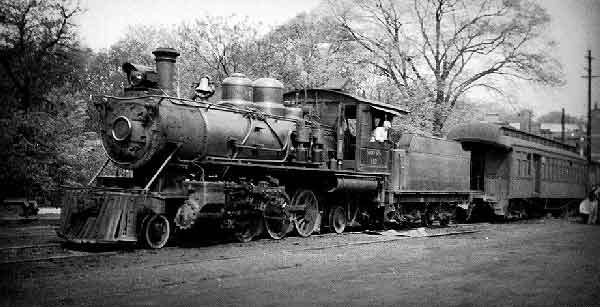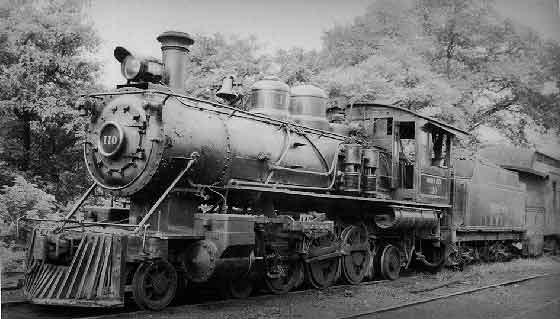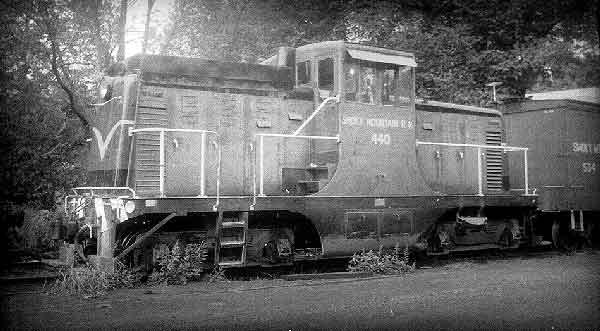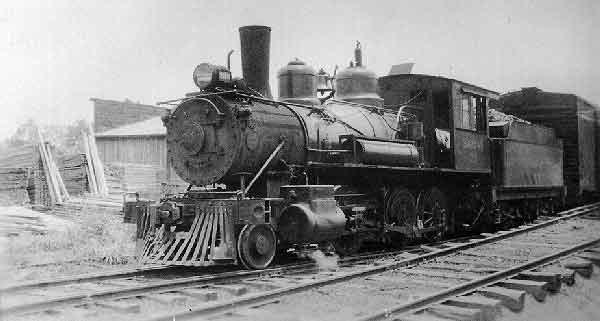TAPLINES
SHORTLINE, NARROW GAUGE AND
INDUSTRIAL RAILROAD PHOTOGRAPHS AND HISTORY
November of 1998
All images and text (and
mistakes and blunders) by Donald R. Hensley, Jr.
All commercial use rights are
reserved and must be cleared by written permission.
The Smoky Mountain
Railroad

Smoky Mountain 110 at Knoxville,
TN on April 30th, 1951
From
the Collection of Donald R. Hensley, Jr.
This meandering thirty mile standard gauge shortline
ran through the foothills of the Great Smoky Mountains, between Vestal
and Sevierville, Tennessee. This region is a rich agricultural and timber
area. This railroad started out as the Knoxville, Sevierville and Eastern
Railway Co. , being incorporated on July 15, 1907 with a capital stock
of $500,000. Construction began in earnest in 1909 and the first
portion of the road was opened between Vestal and Sevierville (27.8 miles
of 56 and 60 lb. rail) on December 20th, 1909. On January 10th, 1910 the
KS&E added 2.2 miles of trackage rights on the Southern Ry.'s Marysville
branch between Vestal and Knoxville for a yearly rental of $2,172.
Sidetracks in Knoxville and depot facilities were also leased from the
Southern for an additional $600 per year.
The railroad was built by the Revilo Construction
Company which was owned by W. J. Oliver, the Chairman of the Board of the
KS&E. Other officers of the company included C. S. McManus as president,
E.G. Oates as Secretary & Treasurer. (Click
here for the KS&E's 1910 timetable from the 1911 Official Guide)
The roads funded debt included $500,000 worth of gold bonds in two mortgages
with a yearly interest of $28,000. A gift of $150,000 of Sevier County
20 year 5 percent bonds were received in exchange for $150,000 worth of
KS&E stock. The bonds were turned over to the construction company
as payment.
An affiliated line called the Pigeon River
RR (incorporated August, 1916) was to build a line from Sevierville to
Pigeon Forge, then on to Gatlinburg and the North Carolina line, which
would have been on the crest line of the Great Smoky Mountains. Only a
small portion of this line was built. (Click
here for a map of all the railroads in the area)
By end of 1919 the railroad owned 4 steam locomotives,
3 passenger cars, 1 combination passenger and baggage car, 6 flat cars,
13 box cars, 1 coal car, 1 stock car and 1 caboose. Operations for
1919 included 16,810 of freight train miles and 40,330 of mixed
service miles. A total of 54,868 passengers were carried along with
48,317 tons of freight. While the net earning of the road was modest (
$5,142 for 1919 ), the funded debt was killing the road. The three years
average deficit from 1917-1919 was $31,000. Fortunately they had a large
surplus from earlier years profits to absorb these deficits, but the handwriting
was on the wall, this couldn't last for very much longer as we shall see!
Foreclosed in July of 1921 by the bank, the KS&E
was purchased by L.C. Gunter for $50,000 on November 1st, 1921 at the foreclosure
sale. Reorganized as the Knoxville and Carolina RR. on November 4th, 1921
and authorized by the ICC to issue new stock and bonds in 1922. This reorganization
would reduce the yearly interest charges from $28,000 to $7,920! With this
new money the railroad began rehabilitating its road and equipment. By
1923 new bonds were issued to help pay for these improvements. Things were
looking up in 1923, passenger revenue was $43,296 and freight revenue was
at $81,626. Net earning were $26,358 with a small surplus after fixed charges
(rent and interest) of $1,795. Equipment for 1925 included 2 steam locomotives,
1 gasoline rail car, 2 passenger cars, 2 combination cars, 4 box cars,
2 flat cars, 1 stock car and 1 caboose. Then further progress came to the
area in three forms: improved roads, the automobile and the truck. By 1925
passenger revenue was down to $10,568 while freight was down to $55,000.
The red ink for that year was $20,888. Times were a changing.
May 1st, 1926 the railroad was sold at auction
to T. Asbury Wright, Jr. for $50,000 for the bond holders. The bondholders
however attempted to sale the road for junk, but Seiver County (owners
of KS&E stock) was able to convince the local court to delay the sale.
A new company was formed, The Smoky Mountain Railroad Co. in August of
1926. Then an appeal to save the road was made by the local people to the
Tennessee and North Carolina Railway Co. The T&NC appeared at the sale
on October 18, 1926 and bought the property for $75,000. The Smoky Mountain
RR charter was given to the new owners ($75,000 stock) and the old KS&E
was operated by T&NC (under a $6,000 a year lease) along with two other
separate branches. The first ran from Newport, TN to Crestmont, NC,
and the second ran from Andrews, NC to Haysville, NC. Newport was
24 miles northeast of Sevierville and lcl shipments were handled between
those two towns using motor trucks on the local roads. To help the new
railroad out, taxes were waived for 5 years, and businesses pledge to use
the SMRR instead of trucks.
Seiver County at this time consisted of 587 square
miles and a population of 25,000 with only the SMRR serving it. The principal
traffic is lumber shipped from the mountanous sections east and south of
Sevierville, a town of 776 persons. The territory crossed by the railroad
is hilly and fertile, farms produce wheat, corn hay and livestock. Part
of this area is underlayed by marble. Of the entire area, 75 percent is
in timber, 15 percent is cultivated and 10 percent in pasture. Manufacturing
includes a cannery, a textile plant, a flour mill and a small chair factory.
Inbound coal is estimated at 300 carloads a year. The output of factories
is said to range from 125 to 150 cars per year. (
Click here for a look at the 1927 timetable from that years Official Guide.)

Smoky Mountain 206 at Knoxville,
TN on August 8, 1948
From
the Collection of Donald R. Hensley, Jr.
Now back to the Pigeon River RR, while only
a small portion was build, this railroad was still operating in 1930 with
a separate owner whom leased it to the SMRR. Located on the east bank of
the Pigeon River in Sevierville this road operated 1.17 miles of track
and served nine industries with 269 cars being handled in which a
switching charge of $6 per car is charged to the SMRR as per the
lease. The SMRR connected with this road on the west bank of the river.
The SMRR acquired this trackage in 1930 and leased it to the T&NC.
Because of the joint operations of the T&NC
its hard to tell how the SMRR property was performing. The T&NC was
operating with a profit in 1928 ($47,422) , 1929 ($27,855) and 1930 ($40,865).
By 1930 only 1 locomotive was owned as well as 2 passenger cars, 2 box
cars and a gas motor car. Then the times turned bad. Losses were registered
in 1932 (-$30,951) and 1933(-$9,029) with only a small profit of
$1,420 in 1934. (Click
here for the 1935 timetable from 1936's Official Guide)
At the end of 1937, the T&NC sold their Smoky
Mountain RR stock to the Midwest Steel Co. of Charleston, WV, a company
that deals in scrap iron. These so called new owners shortly concluded
that the terms of the lease were not being complied with by the T&NC,
they then terminated the lease effected on March 6, 1938. But as these
new owners did not want to operate the line themselves, a new amended lease
was made with the T&NC for temporary operations pending a determination
to its future. On April 11, 1938, the Smoky Mountain RR (by its new owners)
applied for abandonment of its entire line with the new owners doing the
honors of scrapping the line.
From these 1938 ICC abandonment proceedings we
learn a little more about the Smoky Mountain. Beginning at Vestal the railroad
serves 14 small non agency stations, ranging in population from 2 to 30
each. Sevierville population was now at 882.
Traffic Table
| type |
1933 |
1934 |
1935 |
1936 |
1937 |
First
3 months
of 1938 |
| carloads freight in cars |
585 |
1560 |
658 |
661 |
654 |
135 |
| less than car load freight in tons |
581 |
731 |
629 |
548 |
556 |
138 |
| automobiles and trucks in car loads |
10 |
|
|
|
26 |
|
| canned goods |
19 |
|
|
|
19 |
|
| cement |
46 |
|
|
|
75 |
|
| coal |
48 |
|
|
|
34 |
|
| explosives |
11 |
|
|
|
56 |
|
| fertilizer |
23 |
|
|
|
21 |
|
| lumber |
52 |
|
|
|
19 |
|
| gasoline |
93 |
|
|
|
182 |
|
| sand stone & gravel |
167 |
|
|
|
83 |
|
| empty tin cans |
10 |
|
|
|
29 |
|
An engineer of the Southern Ry. Co. inspected the
line for the ICC. He reported that there was considerable deferred maintenance
and it would cost between $44,100 and $49,600 to place the line in good
condition. He also testified that the road could be operated in its present
condition. Protestants of the abandonment contend that the line has operated
profitably in the past and can be made to do so in the future.
Also reported was the construction of a new highway
near Gatlinburg (the gateway to the Great Smoky National Park) will bring
in about 60 car loads of cement and 190 cars of sand in 1938. This road
will be extended all the way to Sevierville (15 miles) within two years
bringing in additional carloads (approx. 400 cars of cement and 1,000 cars
of sand!)
The main source of income in Sevierville was
the Stokely Brothers & Co. which operates a vegetable canning factory
in Sevierville, producing 125,000 cases of can goods annually and employing
200 people from May to October. Outbound shipment consists of canned goods,
while in bound consists of empty tin cans (from Baltimore, MD), fertilizer,
shipping containers and coal. In all 46 carloads were received and 19 were
forwarded by this plant. There are also three bulk oil stations in town
which furnished the most constant revenue for the railroad in the later
years with inbound shipments of gasoline and heating oil.
The ICC denied the abandonment of the Smoky Mountain
RR, but allowed the T&NC to cease operations over the line. This left
the Midwest Steel Co. as the sole operator of the line much to their dismay.
They then tried to raise money by applying for a RFC loan from the US Government,
but the ICC denied their application. (Click
here for the 1942 Timetable from that years Official Guide)

Smoky Mountain # 110 at Knoxville,
TN on July 6, 1952
From
the Collection of Donald R. Hensley, Jr.
The building of the Douglass Dam on the Little Pigeon
River provide much needed revenue and a long spur was built to handle the
traffic. World War II's gasoline rations brought about increases in its
train ridership. By 1946 the line was once again losing money. In January
of 1947 a washout from a clogged culvert and the scrap company owners jumped
at the opportunity to force abandonment. Claiming it would cost thousands
of dollars to repair (the wash out only covered 2 rail lengths) and no
money in the till, they applied for abandonment which was denied. Then
the owners applied for bankruptcy protection in March, but had to repair
the line in the meanwhile. The ICC approved a loan for $10,000 and four
of their customers came up with $3,750 and the line was back in operation
by summer. In April of 1948 General Frank Maloney was named trustee by
the Federal Court. But the scrap owners still were pressing for abandonment
saying that the line was in too bad of shape to operate. This was disputed
by Maloney.

Smoky Mountain # 440 at Knoxville,
TN on September, 27, 1957
From
the Collection of Donald R. Hensley, Jr.
The shippers, who had came up with the money for
fixing the washout, decided they have heard enough, took action by forcing
receivership through the local court, naming John B. Waters as receiver.
This started a little tug and war match with the federal court that ended
with the county court in charge. By 1951 (John Temple, reciever)
passenger traffic was dropped, leaving only freight and express for the
little road to carry. By 1958 receivership had ended with B.M. Angeli (Indianapolis,
IN) as president of the SMRR. In February of 1962 the president was John
B. Waters of the Sevierville Bank. Abandonment soon followed though scrapping
did not occur until 1964.

Smoky Mountain 206 at Sevierville,
TN
From
the Collection of Donald R. Hensley, Jr.
LOCOMOTIVE ROSTER
(Thanks to Robert W. Brendel)
Knoxville, Sevierville & Eastern 1909-1921
Knoxville & Carolina 1921-1926
NUMBER
TYPE
BUILDER C/N
DATE
HISTORY
| 20 |
4-6-0 |
Baldwin |
|
|
|
| 34 |
4-4-0 |
Baldwin |
6941 |
9/83 |
ex Cin.Southern # 81, re CNO&TP # 581, re # 545, re Southern
# 6401, to Eagle Coal # 31 6/17, to SI&E # 1190, to KS&E #34 9/14/18 |
| 35 |
2-6-0 |
Baldwin |
14407 |
8/95 |
Mobile & Birm. # 14, re Southern # 3001, to KS&E 4/15 |
| 36 |
4-6-0 |
Baldwin |
15502 |
9/97 |
Mobile & Birm. # 16, re # Southern #s 704, 657, 1378, to KS&E
1915 |
SMOKY MOUNTAIN RY. 1926-1961
| 102 |
2-6-2 |
Lima |
1327 |
12/13 |
Tenn. & NC # 5, re# 102, to SM # 102
scrapped c1943 |
| 107 |
2-8-0 |
Baldwin |
8869 |
11/87 |
ETV&G # 419, re # Southern # 107, to SM # 107 on 5/16/1942.
To grover Robbins, Jr. and on display at Pigeon Forge, TN |
| 110 |
4-6-2 |
Baldwin |
37303 |
11/11 |
Little River # 110, to SM # 110 in 1942.
To Terry Bloom, Brooksville, OH 5/1972 |
| 206 |
4-6-2 |
Baldwin |
34964 |
7/10 |
Genesse & Wyoming # 9, to SI&E # 1498 in 1918, to Brooklyn
Cooperage # 16 11/19, to BR&L 8/29 to SM # 206
To Grover Robbins, Jr., on display at Pigeon Forge, TN |
| 440 |
44 tonner |
GE |
|
|
|
Bibliography
Smoky Mountain by William H. Schmidt, Jr.
Trains, December of 1949
ICC reports
Official Guides and Equipment Registers
Roster by Robert W. Brendel
Photos collection of Don Hensley
Many thanks to Russell Tedder for supplying
new additional research material for which this much expanded history relied
much upon.
Return
to Main Page




